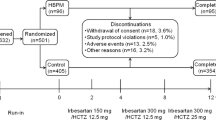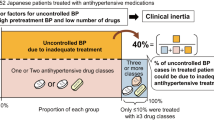Abstract
Resistant hypertension is common among the hypertensive population with reported prevalence of 12 to 15%. These patients have a higher cardiovascular risk and consequently a poorer cardiovascular prognosis. Suboptimal adherence with antihypertensive medication is a common contributing factor in apparent treatment-resistant hypertension. Patients were observed taking their medications under direct supervision at our directly observed therapy (DOT) clinic. At the DOT clinic visit, patients were fitted with a 24-h ambulatory blood pressure (ABP) monitor and each drug, at currently prescribed dose, was administered by a nurse; at an hourly interval and patient observed for 7 h. ABP readings between pre and post DOT clinic were compared. Fifty out of 56 patients had complete data on the ABP. Twenty four were female and the mean (s.d.) age was 62.0 (11.0) years. On the basis of the study methods that differentiated patients according to their BP response during the DOT clinic, twenty-five (50.0%) patients were deemed to be truly resistant (24-h ambulatory systolic blood pressure (SBP) fall <5 mm Hg) and the remaining 25 were deemed to have clinically significant non-adherence (24-h ambulatory SBP fall ⩾5 mm Hg) to prescribed therapy. In non-adherent patients, the mean 24-h ambulatory BP drop observed was 19.5/9.4 mm Hg (P<0.001 for both). Our results suggest that non-adherence is very common among patients considered to have apparent treatment-resistant hypertension. DOT clinic can be an effective method of identifying the truly resistant hypertensive patients.
This is a preview of subscription content, access via your institution
Access options
Subscribe to this journal
Receive 12 digital issues and online access to articles
$119.00 per year
only $9.92 per issue
Buy this article
- Purchase on Springer Link
- Instant access to full article PDF
Prices may be subject to local taxes which are calculated during checkout


Similar content being viewed by others
References
Murray CJL, Lopez AD . Measuring the global burden of disease. N Engl J Med 2013; 369 (5): 448–457.
Mancia G, Fagard R, Narkiewicz K, Redon J, Zanchetti A, Bohm M et al. 2013 ESH/ESC Guidelines for the management of arterial hypertension: the Task Force for the management of arterial hypertension of the European Society of Hypertension (ESH) and of the European Society of Cardiology (ESC). J Hypertens 2013; 31 (7): 1281–1357.
National Institute for Health and Clinical Excellence Hypertension: Clinical Management of Primary Hypertension in Adults. National Institute for Health and Clinical Excellence London, UK, 2011.
de la Sierra A, Segura J, Banegas JR, Gorostidi M, de la Cruz JJ, Armario P et al. Clinical features of 8295 patients with resistant hypertension classified on the basis of ambulatory blood pressure monitoring. Hypertension 2011; 57 (5): 898–902.
Persell SD . Prevalence of resistant hypertension in the United States, 2003–2008. Hypertension 2011; 57 (6): 1076–1080.
Egan BM, Zhao Y, Axon RN, Brzezinski WA, Ferdinand KC . Uncontrolled and apparent treatment resistant hypertension in the United States, 1988 to 2008. Circulation 2011; 124 (9): 1046–1058.
Roger VL, Go AS, Lloyd-Jones DM, Adams RJ, Berry JD, Brown TM et al. Heart disease and stroke statistics—2011 update: a report from the American Heart Association. Circulation 2011; 123 (4): e18–e209.
Daugherty SL, Powers JD, Magid DJ, Tavel HM, Masoudi FA, Margolis KL et al. Incidence and prognosis of resistant hypertension in hypertensive patients. Circulation 2012; 125 (13): 1635–1642.
Salles GF, Cardoso CL, Muxfeldt ES . Prognostic influence of office and ambulatory blood pressures in resistant hypertension. Arch Int Med 2008; 168 (21): 2340–2346.
Elliott WJ . Improving outcomes in hypertensive patients: focus on adherence and persistence with antihypertensive therapy. J Clin Hypertens 2009; 11 (7): 376–382.
Mazzaglia G, Mantovani LG, Sturkenboom MC, Filippi A, Trifiro G, Cricelli C et al. Patterns of persistence with antihypertensive medications in newly diagnosed hypertensive patients in Italy: a retrospective cohort study in primary care. J Hypertens 2005; 23 (11): 2093–2100.
Van Wijk BL, Klungel OH, Heerdink ER, de Boer A . Rate and determinants of 10-year persistence with antihypertensive drugs. J Hypertens 2005; 23 (11): 2101–2107.
Yiannakopoulou EC, Papadopulos JS, Cokkinos DV, Mountokalakis TD . Adherence to antihypertensive treatment: a critical factor for blood pressure control. Eur J Cardiovasc Prev Rehabil 2005; 12 (3): 243–249.
Romanelli RJ, Schiro TA, Jukes T, Wong KS, Ishisaka DY . Disparities in blood pressure control within a community-based provider network: an exploratory analysis. Ann Pharmacother 2011; 45 (12): 1473–1482.
DiMatteo MR . Variations in patients' adherence to medical recommendations: a quantitative review of 50 years of research. Med Care 2004; 42 (3): 200–209.
Krousel-Wood M, Holt E, Joyce C, Ruiz R, Dornelles A, Webber LS et al. Differences in cardiovascular disease risk when antihypertensive medication adherence is assessed by pharmacy fill versus self-report: the Cohort Study of Medication Adherence among Older Adults (CoSMO). J Hypertens 2015; 33 (2): 412–420.
Jung O, Gechter JL, Wunder C, Paulke A, Bartel C, Geiger H et al. Resistant hypertension? Assessment of adherence by toxicological urine analysis. J Hypertens 2013; 31 (4): 766–774.
Burnier M, Wuerzner G, Struijker-Boudier H, Urquhart J . Measuring, analyzing, and managing drug adherence in resistant hypertension. Hypertension 2013; 62 (2): 218–225.
Christensen A, Osterberg LG, Hansen EH . Electronic monitoring of patient adherence to oral antihypertensive medical treatment: a systematic review. J Hypertens 2009; 27 (8): 1540–1551.
Belknap R, Weis S, Brookens A, Au-Yeung KY, Moon G, DiCarlo L et al. Feasibility of an ingestible sensor-based system for monitoring adherence to tuberculosis therapy. PLoS ONE 2013; 8 (1): e53373.
Nelson MR, Reid CM, Ryan P, Willson K, Yelland L . Self-reported adherence with medication and cardiovascular disease outcomes in the Second Australian National Blood Pressure Study (ANBP2). Med J Aust 2006; 185 (9): 487–489.
Kettani F, Dragomir A, Côté R, Roy L, Bérard A, Blais L et al. Impact of a better adherence to antihypertensive agents on cerebrovascular disease for primary prevention. Stroke 2009; 40 (1): 213–220.
Mazzaglia G, Ambrosioni E, Alacqua M, Filippi A, Sessa E, Immordino V et al. Adherence to antihypertensive medications and cardiovascular morbidity among newly diagnosed hypertensive patients. Circulation 2009; 120 (16): 1598–1605.
Bailey JE, Wan JY, Tang J, Ghani MA, Cushman WC . Antihypertensive medication adherence, ambulatory visits, and risk of stroke and death. J Gen Int Med 2010; 25 (6): 495–503.
Corrao G, Parodi A, Nicotra F, Zambon A, Merlino L, Cesana G et al. Better compliance to antihypertensive medications reduces cardiovascular risk. J Hypertens 2011; 29 (3): 610–618.
Esposti LD, Saragoni S, Benemei S, Batacchi P, Geppetti P, Di Bari M et al. Adherence to antihypertensive medications and health outcomes among newly treated hypertensive patients. ClinicoEconomics Outcomes Res 2011; 3: 47–54.
Chowdhury R, Khan H, Heydon E, Shroufi A, Fahimi S, Moore C et al. Adherence to cardiovascular therapy: a meta-analysis of prevalence and clinical consequences. Eur Heart J 2013; 34 (38): 2940–2948.
Burnier M, Schneider MP, Chiolero A, Stubi CL, Brunner HR . Electronic compliance monitoring in resistant hypertension: the basis for rational therapeutic decisions. J Hypertens 2001; 19 (2): 335–341.
Waeber B, Vetter W, Darioli R, Keller U, Brunner HR . Improved blood pressure control by monitoring compliance with antihypertensive therapy. Int J Clin Pract 1999; 53 (1): 37–38.
Trazzi S, Mutti E, Frattola A, Imholz B, Parati G, Mancia G . Reproducibility of non-invasive and intra-arterial blood pressure monitoring: implications for studies on antihypertensive treatment. J Hypertens 1991; 9 (2): 115–119.
Prisant LM, Carr AA, Bottini PB, Thompson WO, Rhoades RB . Repeatability of automated ambulatory blood pressure measurements. J Fam Pract 1992; 34 (5): 569–574.
Staessen JA, Wang J, Thijs L . Cardiovascular protection and blood pressure reduction: a meta-analysis. Lancet 2001; 358 (9290): 1305–1315.
Bhatt DL, Kandzari DE, O'Neill WW, D'Agostino R, Flack JM, Katzen BT et al. A controlled trial of renal denervation for resistant hypertension. N Engl J Med 2014; 370 (15): 1393–1401.
Rang HP, Dale MM, Ritter JM, Flower RJ, Henderson G . Rang & Dale’s Pharmacology, 7th edn, Churchill Livingstone Edinburgh, 2012.
Bunker J, Callister W, Chang CL, Sever PS . How common is true resistant hypertension? J Hum Hypertens 2011; 25 (2): 137–140.
Fadl Elmula FEM, Hoffmann P, Fossum E, Brekke M, Gjønnæss E, Hjørnholm U et al. Renal sympathetic denervation in patients with treatment-resistant hypertension after witnessed intake of medication before qualifying ambulatory blood pressure. Hypertension 2013; 62 (3): 526–532.
Fadl Elmula FEM, Hoffmann P, Larstorp AC, Fossum E, Brekke M, Kjeldsen SE et al. Adjusted drug treatment is superior to renal sympathetic denervation in patients with true treatment-resistant hypertension. Hypertension 2014; 63 (5): 991–999.
Tomaszewski M, White C, Patel P, Masca N, Damani R, Hepworth J et al. High rates of non-adherence to antihypertensive treatment revealed by high-performance liquid chromatography-tandem mass spectrometry (HP LC-MS/MS) urine analysis. Heart 2014; 100 (11): 855–861.
Ceral J, Habrdova V, Vorisek V, Bima M, Pelouch R, Solar M . Difficult-to-control arterial hypertension or uncooperative patients? The assessment of serum antihypertensive drug levels to differentiate non-responsiveness from non-adherence to recommended therapy. Hypertension Res 2011; 34 (1): 87–90.
Strauch B, Petrak O, Zelinka T, Rosa J, Somloova Z, Indra T et al. Precise assessment of noncompliance with the antihypertensive therapy in patients with resistant hypertension using toxicological serum analysis. J Hypertens 2013; 31 (12): 2455–2461.
Naderi SH, Bestwick JP, Wald DS . Adherence to drugs that prevent cardiovascular disease: meta-analysis on 376,162 patients. The Am J Med 2012; 125 (9): 882–887.
Feinstein AR . On white-coat effects and the electronic monitoring of compliance. Arch Int Med 1990; 150 (7): 1377–1378.
Brinker S, Pandey A, Ayers C, Price A, Raheja P, Arbique D et al. Therapeutic drug monitoring facilitates blood pressure control in resistant hypertension. J Am Coll Cardiol 2014; 63 (8): 834–835.
Wetzels GE, Nelemans P, Schouten JS, Prins MH . Facts and fiction of poor compliance as a cause of inadequate blood pressure control: a systematic review. J Hypertens 2004; 22 (10): 1849–1855.
Wetzels GEC, Nelemans PJ, Schouten JSAG, Dirksen CD, van der Weijden T, Stoffers HEJH et al. Electronic monitoring of adherence as a tool to improve blood pressure control*: a randomized controlled trial. Am J Hypertens 2007; 20 (2): 119–125.
Esler MD, Krum H, Schlaich M, Schmieder RE, Böhm M, Sobotka PA . Renal sympathetic denervation for treatment of drug-resistant hypertension: one-year results from the symplicity htn-2 randomized, controlled trial. Circulation 2012; 126 (25): 2976–2982.
Easthall C, Song F, Bhattacharya D . A meta-analysis of cognitive-based behaviour change techniques as interventions to improve medication adherence. BMJ Open 2013; 3 (8): e002749.
Weir MR, Hsueh WA, Nesbitt SD, Littlejohn TJ, Graff A, Shojaee A et al. A titrate-to-goal study of switching patients uncontrolled on antihypertensive monotherapy to fixed-dose combinations of amlodipine and olmesartan medoxomil±hydrochlorothiazide. J Clin Hypertens 2011; 13 (6): 404–412.
Author information
Authors and Affiliations
Corresponding author
Ethics declarations
Competing interests
The authors declare no conflict of interest.
Rights and permissions
About this article
Cite this article
Hameed, M., Tebbit, L., Jacques, N. et al. Non-adherence to antihypertensive medication is very common among resistant hypertensives: results of a directly observed therapy clinic. J Hum Hypertens 30, 83–89 (2016). https://doi.org/10.1038/jhh.2015.38
Received:
Revised:
Accepted:
Published:
Issue Date:
DOI: https://doi.org/10.1038/jhh.2015.38
This article is cited by
-
Cross-cultural adaptation of the Spanish MINICHAL instrument into English for use in the United Kingdom
Health and Quality of Life Outcomes (2022)
-
Rapid treatment of moderate to severe hypertension using a novel protocol in a single-centre, before and after interventional study
Journal of Human Hypertension (2020)
-
Medication Non-adherence: a Major Cause of Resistant Hypertension
Current Cardiology Reports (2020)
-
How to Screen for Non-Adherence to Antihypertensive Therapy
Current Hypertension Reports (2016)
-
Device-based Therapy for Hypertension
Current Hypertension Reports (2016)



